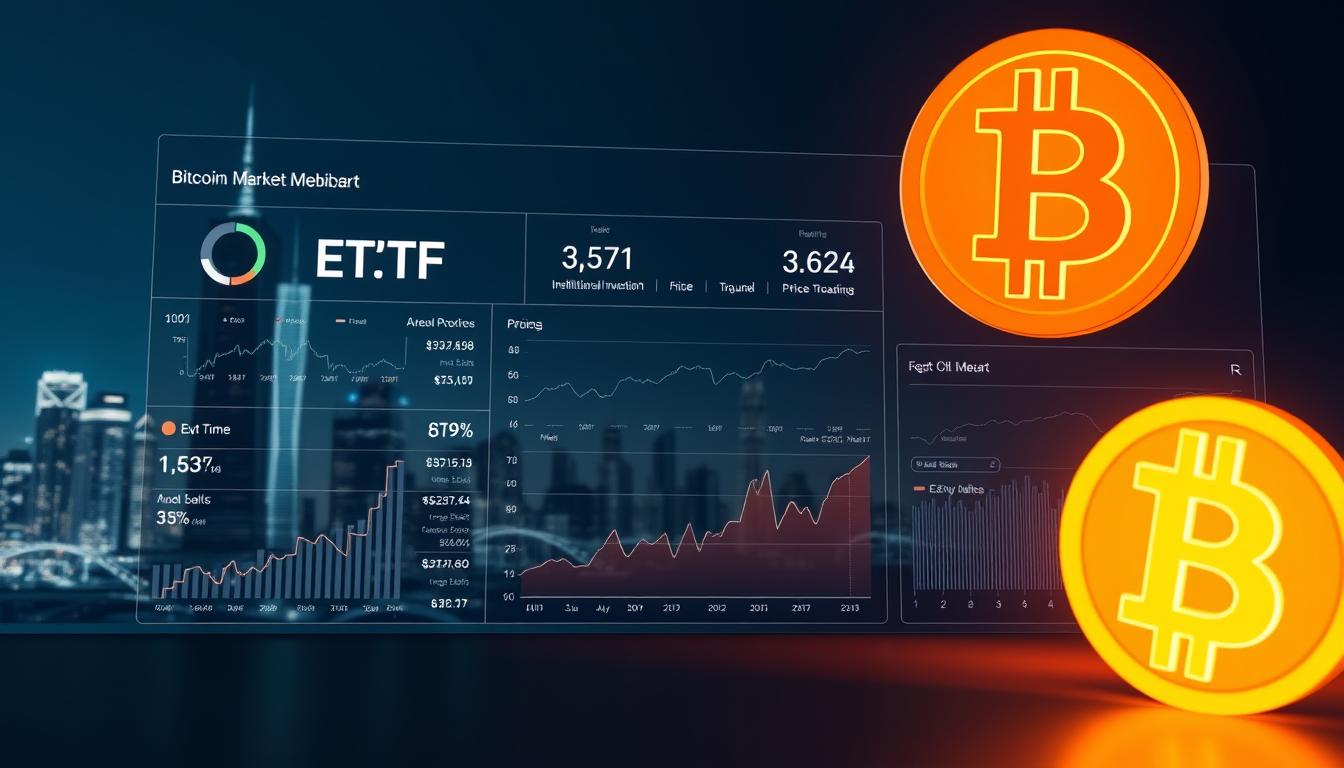Now Reading: Insights into Bitcoin institutional demand ETF inflows
- 01
Insights into Bitcoin institutional demand ETF inflows
Insights into Bitcoin institutional demand ETF inflows

The digital asset landscape underwent a dramatic transformation in 2025. A new era of mainstream acceleration began, powered by major financial institutions. This shift fundamentally reshaped how capital enters the crypto space.
Record-breaking capital movement defined the year. Over $6.96 billion flowed into these new investment vehicles annually. BlackRock’s IBIT fund neared a monumental $100 billion in assets under management.
By mid-October 2025, total investments into spot products for major digital currencies surpassed $48.7 billion. This occurred despite normal market volatility. U.S. funds now hold approximately 1.66 million BTC, about 6.4% of the entire supply.
This ecosystem has become the core engine for market liquidity. The daily flow of capital into these funds now influences price direction more significantly than the activity of any single large holder. The data reveals a profound change in market structure.
Market Trends and Institutional Crypto Adoption
Corporate and investment fund strategies evolved dramatically to include significant exposure to digital assets. This change reflects a deeper acceptance of crypto as a core component of a modern portfolio.
Institutional Capital Shifts and Data Insights
The flow of major capital into this space reached new heights in 2024. U.S. investment vehicles attracted a staggering $1.1 trillion, simplifying access for large-scale players.
Experts like Kevin Lee highlight a key trend. “Price-insensitive” investors now use market dips for strategic rebalancing. This tactic fueled a massive $340 million single-day reversal in October 2025.
Furthermore, corporate treasury holdings ballooned past $6.7 billion. This move shows adoption is not limited to funds but is a balance sheet strategy.
Key Drivers of Mainstream Digital Asset Adoption
Several powerful forces are pushing this widespread acceptance. Clearer regulations have given many firms the confidence to proceed.
Other critical factors include:
- Improved custody solutions that securely hold digital assets.
- Standardized products that fit familiar investment frameworks.
- A growing view of certain digital currencies as a macro hedge.
This confidence was clear after a major political event, triggering record daily capital movement of $1.38 billion. The data shows a new, more stable market dynamic is emerging.
Bitcoin Institutional Demand ETF Inflows: An In-Depth Look
A new analytical framework has emerged where fund flow data provides unprecedented market transparency. This approach reveals how capital movements directly influence daily price action.
Understanding ETF Flow Dynamics
Recent data shows fresh capital entering investment vehicles, with BlackRock’s iShares Trust leading the way. These movements have become the primary driver of daily trading patterns.
The relationship between capital movements and price action follows consistent patterns. Large capital entries often precede breakthroughs above resistance levels. Conversely, exits typically signal upcoming price corrections.
| Flow Pattern | Market Impact | Typical Duration | Signal Strength |
|---|---|---|---|
| Sustained positive flows | Breakthrough resistance | 3-7 days | Strong bullish |
| Single-day surge | Short-term rally | 1-2 days | Moderate bullish |
| Gradual outflows | Consolidation phase | 5-10 days | Neutral to bearish |
| Sharp outflow spike | Potential bottom | 2-3 days | Contrarian bullish |
Implications for Market Momentum
Glassnode research suggests that exit phases may actually indicate market bottoms. These periods often remove weaker positions before rebounds occur.
The total annual capital movement demonstrates sustained interest throughout 2025. This establishes these products as the dominant channel for major investment exposure.
The interplay between flow trends and macroeconomic conditions creates complex dynamics. This relationship has transformed how analysts gauge market sentiment and predict price movements.
Key Performance Metrics in ETF Markets
Market share distribution among major issuers highlights significant concentration trends. BlackRock’s IBIT product demonstrates unprecedented leadership with approximately $100 billion in assets under management.
This represents between 48.5% and 61.4% of total market share among similar products. The scale establishes IBIT as the most successful crypto-focused launch in history.
Performance metrics reveal IBIT’s competitive advantages including institutional-grade infrastructure. The product’s 0.25% expense ratio provides six times greater cost efficiency compared to Grayscale’s 1.5% fees.
Early regulatory approval positioned BlackRock as the primary gateway for major investment exposure. Fidelity’s FBTC maintains approximately $30 billion in assets while Grayscale’s GBTC holds $23 billion.
Newer entrants like Bitwise’s BITB show consistent positive movement with $17.4 million in recent activity. Meanwhile, legacy products experienced notable exits reflecting fee-conscious reallocation.
BlackRock’s Ethereum offering demonstrates exceptional growth with 266.1% quarter-over-quarter expansion. Assets surged from $4.4 billion to $16 billion, capturing 58.2% of that specific market.
These metrics establish that concentration among top-tier issuers defines the mature landscape. Investors now have clear benchmarks for evaluating products based on assets, fees, and adoption rates.
Institutional Movements and Corporate Treasury Strategies
MicroStrategy’s groundbreaking approach to treasury management sparked a wave of corporate cryptocurrency adoption across multiple industries. The company accumulated 257,000 units of the leading digital asset in 2024 alone.
This established a $2+ billion treasury strategy that inspired dozens of other corporations. Companies moved from traditional cash management to strategic digital asset allocation.

MicroStrategy and Corporate Treasury Innovations
The firm pioneered using convertible debt offerings to acquire digital assets. This created a new corporate finance playbook for cryptocurrency accumulation.
Total corporate holdings surged past $6.7 billion. This demonstrates that institutional movements extend into operational corporate finance decisions.
Diversification and Strategic Asset Allocation
Companies now diversify beyond single digital assets. Windtree Therapeutics allocated $520 million for BNB holdings.
Sharps Technology committed $400 million for Solana acquisition. These moves show sophisticated portfolio management approaches.
| Company | Primary Asset | Allocation Value | Strategy Type |
|---|---|---|---|
| MicroStrategy | Leading Digital Asset | $2+ Billion | Core Treasury Reserve |
| Windtree Therapeutics | BNB | $520 Million | Diversified Portfolio |
| Sharps Technology | Solana | $400 Million | Strategic Acquisition |
| Multiple Corporations | Various Assets | $6.7+ Billion | Balance Sheet Integration |
Corporations now view digital assets as strategic reserves rather than speculative investments. This represents a fundamental paradigm shift in treasury management philosophy.
Regulatory Approvals and Impact on ETF Inflows
Policy clarity emerged as the decisive factor driving unprecedented capital movement into digital asset products. The regulatory environment underwent dramatic transformation, creating new opportunities for mainstream participation.
Evolution of SEC Approval Timelines
The January 2024 approval marked a watershed moment. Capital deployment accelerated by 400%, expanding from $15 billion to $75 billion within one quarter.
By September 2025, the framework became significantly more efficient. Approval times dropped from 270 days to just 75 days, representing a 72% improvement.
Trump Administration’s Crypto-Friendly Policies
Four transformative executive orders repositioned the United States as a crypto capital. These included the Digital Financial Technology leadership order and Strategic Reserve establishment.
The 401k inclusion policy and CBDC prohibition further solidified this supportive stance. Geopolitical developments like the anticipated Trump-Xi summit added additional catalysts.
| Regulatory Milestone | Date | Impact on Capital |
|---|---|---|
| SEC Approval Framework | January 2024 | 400% acceleration |
| Streamlined Review Process | September 2025 | 72% faster approvals |
| Digital Technology Order | January 23, 2025 | Enhanced leadership position |
| Strategic Reserve Establishment | March 6, 2025 | Long-term legitimacy |
This comprehensive policy evolution created predictable pathways for new investment products. The infrastructure now supports streamlined spot approvals for assets with established markets.
Market Infrastructure and Technological Ecosystems
Advanced blockchain ecosystems now provide the foundational layers necessary for mainstream crypto integration across financial markets. This technological infrastructure supports scalable adoption and enhances market liquidity.
Layer 2 Scaling Solutions and DeFi Innovations
Base leads the Layer 2 ecosystem with $4.94 billion in total value locked. This represents 43.5% market share in the $11.36 billion scaling solutions market.
The competitive landscape shows Base surpassing Arbitrum’s previous dominance. Layer 2 networks collectively hold over $10.4 billion, providing cost-efficient transaction infrastructure.
AAVE dominates decentralized finance lending with $24.4 billion TVL across 13 blockchains. The protocol shows remarkable 19.78% monthly growth.
| Technology | Leading Platform | Total Value | Market Share |
|---|---|---|---|
| Layer 2 Scaling | Base | $4.94B | 43.5% |
| DeFi Lending | AAVE | $24.4B | Market Leader |
| Liquid Staking | Lido | $22.6B | Significant Share |
| Overall DeFi | Ethereum | 66.7% | Liquidity Dominance |

Real-World Asset Tokenization and Blockchain Trends
Real-world asset tokenization represents the fastest-growing sector. The market expanded from $8.5 billion in early 2024 to $33.91 billion by Q2 2025.
This 380% growth rate demonstrates strong institutional interest. BlackRock’s BUIDL fund holds $2.9 billion in tokenized U.S. Treasuries.
The introduction of ERC-7943 compliance standards provides regulatory clarity. This framework enables institutional participation while maintaining compliance requirements.
These infrastructure developments create the foundational layers for sustained crypto adoption. The maturation across scaling, DeFi, and tokenization supports broader market integration.
Macro, Geopolitical, and Economic Influences on Crypto
The interplay between macroeconomic indicators and geopolitical events shaped cryptocurrency valuation patterns significantly. These external forces created both opportunities and challenges throughout the period.
Global Trade Dynamics and Policy Shifts
International diplomatic developments played a crucial role in market sentiment. The anticipated Trump-Xi summit generated optimism about eased trade tensions.
This potential resolution revived risk-on appetite among global investors. Supportive U.S. administration policies further strengthened the bullish narrative.
Macroeconomic Factors and Institutional Confidence
Traditional economic metrics showed favorable conditions for digital assets. The 10-year Treasury yield near 4.3% and cooling CPI at 3.0% signaled potential Fed rate cuts.
A weakening dollar traditionally supports alternative asset prices. Large positions worth $255 million indicated sophisticated investor confidence.
However, volatility remained a concern with $500 billion in value erased since October’s peak. The crypto market continues reflecting broader economic health through traditional index correlations.
ETFs as Market Liquidity Engines
Market structure evolution now positions investment funds as the dominant liquidity providers rather than traditional participants. These instruments control significant portions of available supply, creating new price discovery mechanisms.

ETF Flow Trends and Liquidity Impact
U.S. investment vehicles collectively hold approximately 1.66 million units of the leading digital asset. This represents about 6.4% of total circulating supply, establishing unprecedented market influence.
Exchange balances reached a six-year low of 2.83 million units. This scarcity amplifies the impact of capital movement through these standardized products on intraday price action.
Recent data shows the market’s sensitivity to flow patterns. A $20.3 million net inflow reversed prior $101 million outflows, triggering immediate price responses.
Historical analysis reveals consistent patterns. Two consecutive positive flow days typically precede rallies averaging 5-8%. This provides traders with quantitative indicators for strategic positioning.
The liquidity impact extends beyond spot markets. Futures volume on major exchanges reached $543.3 billion in October, demonstrating how institutional leverage positioning follows these flow trends.
Institutional Investment Strategies and Actionable Insights
Financial institutions require actionable insights to capitalize on emerging digital asset opportunities. The current market environment offers unprecedented access through standardized products.
Professional market analysis reports provide essential guidance for navigating this complex landscape. These resources help investors develop effective approaches.
Strategic Allocation and Risk Management
A phased investment strategy minimizes initial risk while capturing upside potential. Starting with 5-10% exposure allows for gradual portfolio integration.
Multi-layer risk protocols ensure comprehensive protection. These include stablecoin reserves for operational needs and automated rebalancing triggers.
Security measures like multisig protocols safeguard digital assets. This balanced approach manages exposure while pursuing growth.
Leveraging ETF Inflows for Long-Term Growth
Understanding capital flow patterns provides valuable signals for strategic positioning. These trends often precede significant market movements.
Maintaining discipline during volatility periods is crucial for long-term success. Patient investors can capitalize on institutional momentum.
Financial institutions should expedite product development to capture emerging opportunities. The streamlined approval process creates competitive advantages.
Altcoin Trends and Price Predictions in a Shifting Landscape
Analysts are observing a pivotal shift where altcoins are beginning to capture a larger share of institutional capital. This rotation became clear in Q3 2025. For the first time, spot products for Ethereum attracted more capital than those for the pioneer digital asset.

This marks a symbolic change in investment patterns. The data shows $8.7 billion moved into Ethereum products versus $7.5 billion for its counterpart. This indicates a diversification phase is underway.
Market metrics provide further evidence. Dominance of the leading asset fell from 65% to 57.4%. Over 75% of top alternative currencies posted better 90-day gains. Analysts link a potential bitcoin price rebound above $120,000 to geopolitical optimism.
Ethereum’s price target centers on the $4,500 level. Deflationary mechanics and network upgrades provide strong support. This creates a compelling outlook for the bitcoin ethereum pair.
| Asset / Sector | Q3 2025 Inflows | Price Target (Nov 2025) | Key Driver |
|---|---|---|---|
| Bitcoin | $7.5 Billion | > $120,000 | Geopolitical Summit |
| Ethereum | $8.7 Billion | $4,500 | Dencun Upgrade |
| Altcoin Sector (e.g., Layer 2) | Significant Momentum | High Growth Potential | 19% Recent Gains |
This market phase favors strategic allocation. High-growth sectors like Layer 2 scaling solutions show strong momentum. Projects in PayFi, like Remittix, have seen a massive surge of over 670% this year.
Investors should focus on altcoin projects with real utility and strong fundamentals. The current landscape offers unique opportunities for diversification and growth.
Data Analysis and Multi-Source Market Perspectives
Multi-source market perspectives reveal critical insights through sophisticated analytical methodologies. This comprehensive approach combines multiple data streams to create a complete picture of the digital asset landscape.
Our analysis leverages Powerdrill Bloom, an AI-powered financial analytics engine. This technology processes real-time institutional flow tracking and on-chain metrics.
Blockchain data shows significant consolidation among major holders. Entities holding at least 1,000 BTC have reached 1,670 addresses, the highest concentration since 2021.
Cross-referencing performance data reveals strong market leadership. One prominent product generated $244.5 million in profits while maintaining over $50 billion in assets.
The DeFi sector demonstrates substantial infrastructure development. Protocols including AAVE, Lido, and EigenLayer collectively control over $57 billion in total value locked.
Quantitative analysis confirms substantial capital movement throughout 2025. Daily flow patterns provide valuable indicators for short-term price movements and sentiment shifts.
This multi-source approach triangulates information across independent data sources. It reduces single-source bias and enhances decision-making confidence for investors navigating this complex landscape.
Conclusion
Strategic positioning in the evolving digital asset space requires understanding the fundamental shifts now underway. The current landscape demonstrates unprecedented momentum across multiple sectors.
This adoption phase reflects a significant shift in market participation. Major players now drive trends that shape price rallies and influence overall value creation.
While volatility remains a factor, the underlying support from regulatory clarity and technological infrastructure suggests sustained growth. This comprehensive analysis provides actionable insights for navigating these dynamic markets.
The convergence of favorable policies, corporate treasury strategies, and spot product innovation creates a multi-year growth trajectory. This positions cryptocurrency for deeper integration into global finance.















